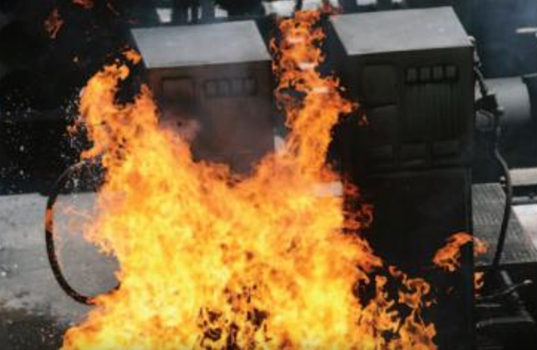By Joe O’Brien
Imagine driving along and looking over to see the motorist in the next lane eating a bowl of cereal and reading a newspaper. It would probably make you tighten your seat belt. Not only did this incident actually happen, this level of distracted driving is not an uncommon occurrence. This kind of recklessness is a major challenge facing operators tasked with maintaining safety at businesses, whether retail fueling or commercial home fueling, where storing and dispensing flammable liquids is a fundamental part of the job.
Preventing distraction-related accidents at fuel sites is an issue of increasing importance for fuel site operators, technicians and fuel suppliers. Recent statistics show:
- 80% of all car accidents are caused by the driver being distracted in some way
- Once a driver has been distracted, it takes only three seconds for an accident to occur
Averting mishaps caused by distracted driving is extremely challenging because much of the risk is created by human behavior. Site operators can do little to change this. For that reason, it is imperative for operators to control what they can. Taking extra precautions through strong safety practices is the best defense against disaster. Here are three important considerations for enhancing fuel site safety to help avoid a catastrophic distracted-driving incident.
Verify the emergency shutoff valves under dispensers are meeting industry best practices for installation
Emergency shutoff valves (also called impact valves, fire valves, shear valves and crash valves) are critical safety features at fuel sites. These valves automatically shut off the flow of fuel if the dispenser is dislodged or the piping is damaged. This could be caused by a collision with the dispenser or a driver pulling away with the nozzle still in the car’s fill pipe. (A quality fuel hose breakaway can help limit damage that might be incurred by a motorist driving off with the nozzle still in their car.).
It is essential emergency shutoff valves meet industry best practices for installation, otherwise their protective capabilities may be eliminated. Emergency shutoff valves need to be securely mounted (usually using a stabilizer bar) and they need to be level with the top surface of the pump island. If moisture is observed on the emergency shutoff valve or on piping below it during inspections, PEI’s “RP500: Inspection & Maintenance of Motor Fuel Dispensing” 1 recommends removing the dispenser for service until it can be repaired.
Make safety barriers as highly visible as possible to protect operators conducting maintenance and deliveries. An effective safety barrier is part common sense, part ingenuity. Here are few tips:
- Position the barrier at a height that is visible from multiple vantage points and a safe distance around the work zone.
- Make safety your first priority, but avoid disrupting traffic as much as possible.
- Strategically park a vehicle to block traffic.
- Utilize reflective materials, lights and yellow warning tape.
Large barricades improve visibility, but often pose a challenge for maintenance operators who haul their equipment in a trailer. Space in storage trailers is often at a premium. Two simple ideas to help improve visibility of work areas—and which take up minimal space in a trailer—have recently been presented to Source:
- Include strings of pennant streamers/flags to mark a work zone perimeter.
- Insert orange bicycle safety flags into traffic cones to significantly increase their visibility.
While these ideas provide little protection in the way of a physical barricade, they are compact, inexpensive and their somewhat unorthodox use at the fuel site may draw extra attention to the work zone.
Evaluate how the fuel site’s layout contributes to overall safety.
Many of the catastrophic automobile-related accidents at fuel sites are caused by vehicles that are driving at high rates of speed on the road that borders the station’s property line. In these situations, the vehicle leaves the roadway and speeds out of control over station property until they collide with something—or someone—at the fuel site. Here are a few traffic-control considerations for a station’s layout:
- Is the fuel site laid out in a way that vehicles—including fuel suppliers—are safely circulated through the property? Avoid installing station equipment near high-traffic areas such as exits and entrances, drive-throughs or car wash lanes.
- Are there landscaping or other curbside features that could be used to slow out-of-control traffic near the perimeter?
- How close are the dispensers to the roadway?
In many ways fuel sites with more acreage are at a significant advantage because they have more flexibility with the layout of their site. Regardless of the property’s size, all operators need to strike a balance between making their station inviting to customers and adopting measures that may help protect them. Trusted fuel system design professionals such as the Source SOLUTIONS Design Group 2 can help develop a fuel site plan that addresses these concerns.
Conclusion
In an effort to reduce distracted driving, many states have banned or limited the use of cellphones while driving. That notwithstanding, enforcement of these laws doesn’t apply to incidents that occur on private property. Will motorists who are unable to legally use their mobile devices on the road adopt the same safe-driving practices in parking lots, at gas stations and in drive-throughs? Or will they be more likely to pick up their cellphones as they enter and exit private property?
Although we’ve focused mostly on distracted driving here, distracted walking is also problematic. The intersection of these two behaviors at any given moment can be a deadly combination at a fuel site. With that in mind, station operators should proactively adjust for today’s distracted lifestyle as soon as possible to create an experience that is safer for customers, employees and partners.
2 http://www.sourcena.com/solutions/solutions-design-group/
 Joe O’Brien is Vice President of Marketing at Source™ North America Corporation. He has more than 20 years of experience in the petroleum equipment fuel industry. Contact him at [email protected] or visit sourcena.com to learn more.
Joe O’Brien is Vice President of Marketing at Source™ North America Corporation. He has more than 20 years of experience in the petroleum equipment fuel industry. Contact him at [email protected] or visit sourcena.com to learn more.
End Note
Fact or Fiction?
While it’s evident that mobile phone usage contributes to distracted driving, cellphones do not look to be a fire hazard at the gas pump as previously rumored. The Petroleum Equipment Institute conducted research to investigate fires occurring during fueling and it did not document a single incident that was sparked by a cellphone. Learn more at www.pei.org/static.









